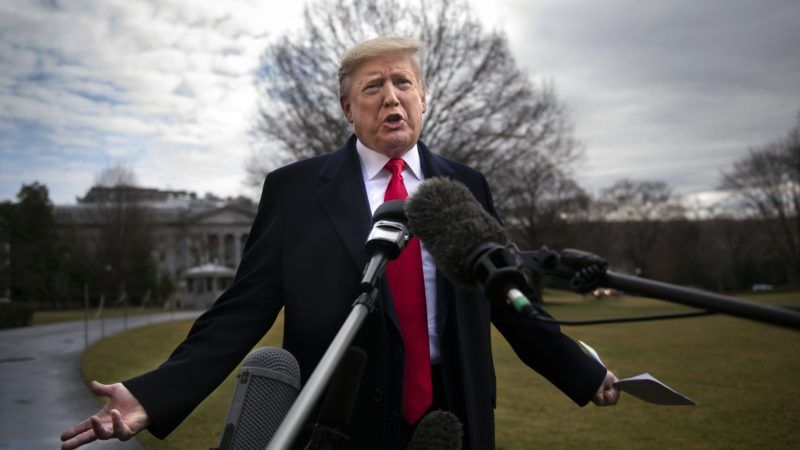Despite $4.4 Trillion in Spending Cuts, Trump's Budget Won't Balance Until 2035
And whether it balances at all depends on some creative accounting. Meanwhile, it proposes $2 billion in new spending on the border wall.

On the campaign trail in 2016, President Donald Trump promised to eliminate the national debt in eight years. On Monday, he will propose a budget that won't even balance for another 15 years—a clear admission that he will leave the federal government's finances in a more precarious state than he found them.
Trump's 2021 budget proposal will be a $4.8 trillion spending plan, according to The Wall Street Journal, which reviewed the White House's budget in advance of its official unveiling on Monday. It calls for an increase in military spending, proposes $2 billion for Trump's planned border wall, and cuts $40 billion from non-military discretionary spending (including a 26 percent cut to the Environmental Protection Agency's budget), the Journal reported on Sunday.
Over the course of the next decade, Trump's budget would cut an estimated $4.4 trillion in domestic spending—including $2 trillion in promised savings from entitlement programs, largely the result of proposed changes in Medicare's prescription drug pricing model.
Overall, federal spending would climb from $4.6 trillion next year to more than $6.5 trillion in 2030. The proposed domestic spending cuts in this year's budget are hardly enough to balance out the spending increases that Congress has passed and Trump has approved in recent years.
Trump proposes $4.4 trillion in cuts to federal spending over a decade, but that is only a fraction of expected $61 trillion in spending and $13 trillion in deficits, per Congressional Budget Office. Progress, but more cuts needed. pic.twitter.com/SgrcBpTsFl
— Chris Edwards (@CatoEdwards) February 10, 2020
Trump's proposal would cut the federal deficit from over $1 trillion in the current fiscal year to a mere $966 billion next year—nearly 50 percent higher than the $666 billion deficit Trump inherited from President Barack Obama in 2017. Trump's budget would have the federal government operating in the red until 2035, the Journal reports.
It's important to keep in mind that all of this is likely the rosiest possible scenario for the federal budget. The budget proposal assumes 3 percent annual growth, a number that has not been achieved since the Bush administration—not even in the immediate aftermath of Trump's tax cuts, which briefly revved the economy—and one that far exceeds the Congressional Budget Office's estimated growth rate of 1.7 percent over the next decade.
And the proposed spending cuts are unlikely to get a warm reception from Congress. Presidential budgets are typically ignored by the legislative branch anyway, but recent history suggests that Trump is unwilling to go to the mat for any aspect of his spending plan. After calling for similar domestic spending cuts last year, Trump turned around and signed a budget deal that hiked spending by $320 billion and obliterated previous spending caps.
The previous year, Trump called for cutting the Department of State's budget by 29 percent and the Environmental Protection Agency's by 25 percent, but Congress instead agreed to a bipartisan budget plan that boosted domestic discretionary spending across the board (while also providing an increase for the Pentagon). And that was when Republicans controlled both houses of Congress.
That Trump has long since abandoned his never-all-that-serious plan to deal with the national debt should be obvious by now. At a private dinner last month, Trump reportedly responded to criticism about inflating the deficit by asking, rhetorically, "Who the hell cares about the budget?" Former congressional deficit hawk Mick Mulvaney, who now heads the White House's Office of Management and Budget, has said "nobody cares" about the deficit. And Vice President Mike Pence went on MSNBC last week to argue that deficits can help boost economic growth—a talking point that used to send Republicans into a tizzy when Obama employed it.
The problem with all that is that a large and growing national debt reduces economic growth. The CBO projects that the average American household will lose between $2,000 and $6,000 in annual wealth by 2040 if the current trajectory continues. It also says America's GDP will shrink by 2 percent over the next two decades if current policies continue and the debt keeps growing.
But short-term thinking dominates Washington these days. And Trump, despite his outsider status, has quickly acclimated to the consensus political view that fixing the national debt will have to be the next president's problem.


Show Comments (153)